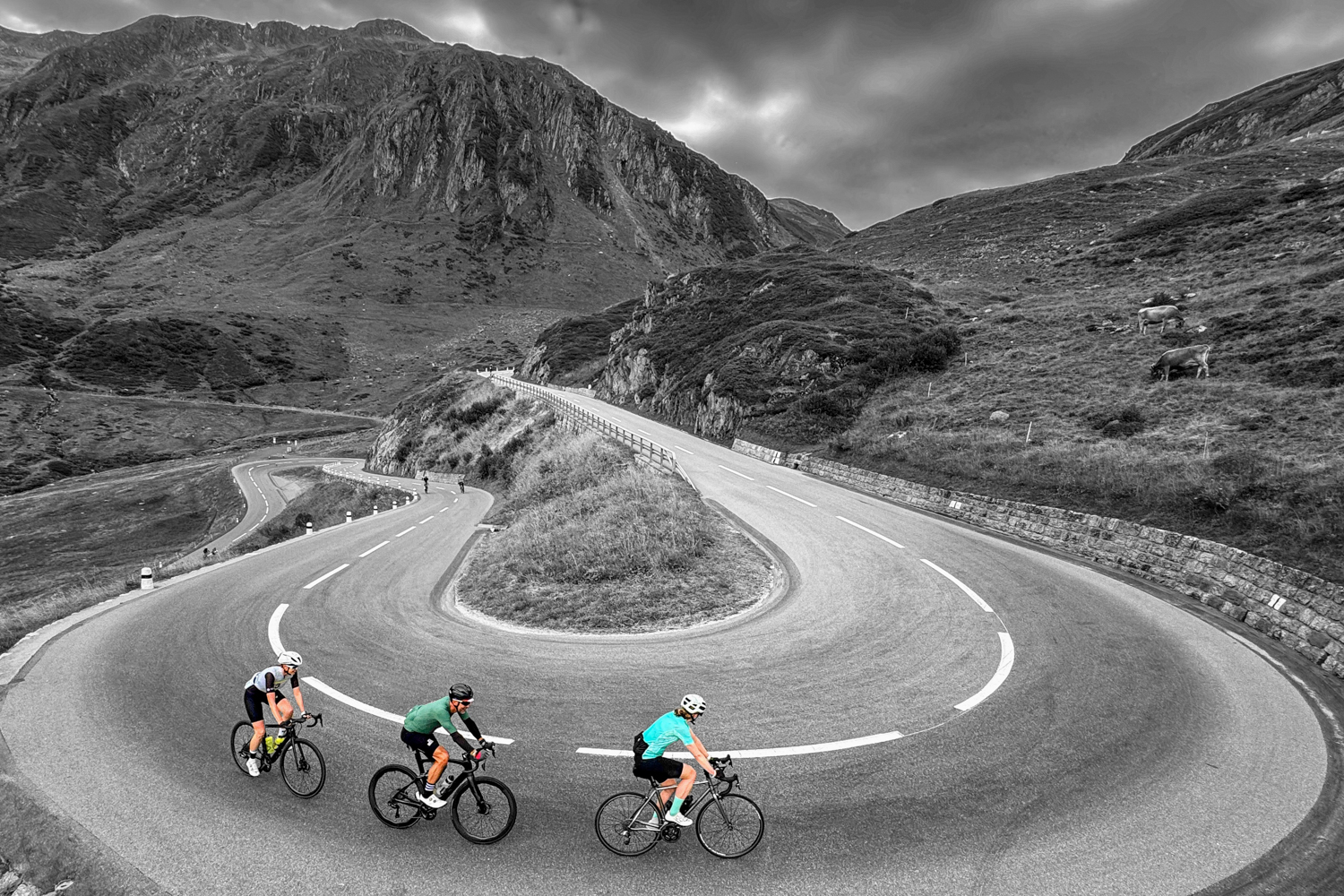9-minute read
So, you’ve booked your cycling holiday and you’re looking forward to riding some of the most epic and fantastic climbs in road cycling history.
There’s just one decision left to make … Do you take your own bike or choose to hire one from Marmot Tours? We hope this blog, compiled with the help of Marmot guide Tom Mutton, will help you make up your mind about which decision is best for you.
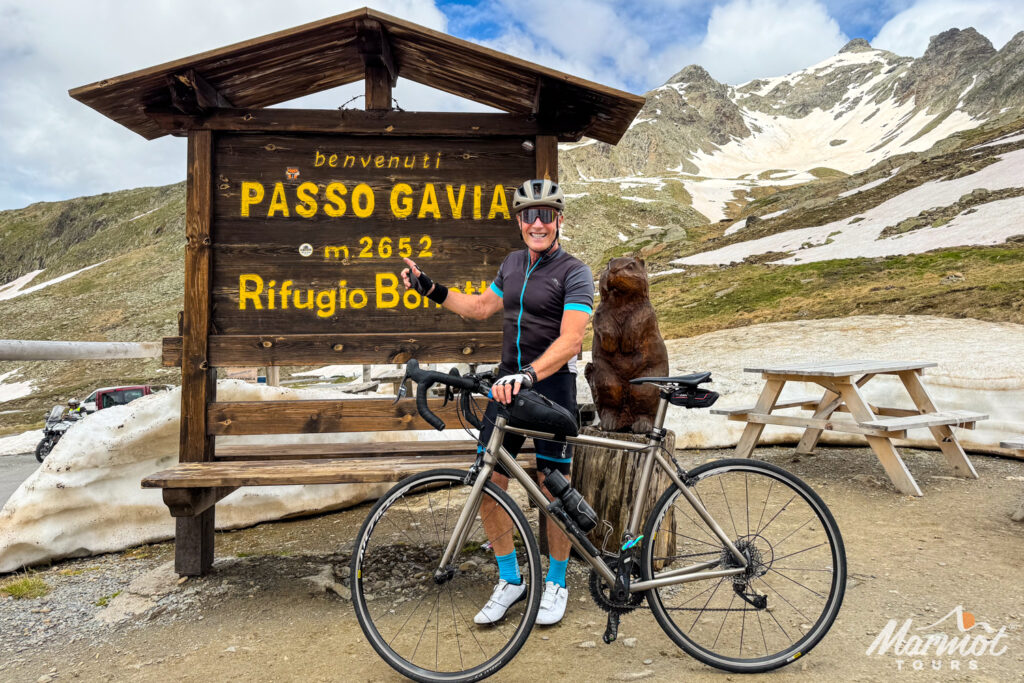
Your road bike vs a Marmot Tours fleet bike
It’s safe to say that there’s nothing like riding your own bike. You know it inside out: how it feels, how it fits, as well as the ride quality and any little quirks it has. If you’re very particular about your set up, we advise you to bring your own bike, to ensure you feel most confident and comfortable on your holiday. However, hiring a bike from us might be a good option of you want to try something different, if you have multiple flights or complicated travel plans, or if you don’t want the inconvenience of packing and rebuilding your own bike.
Taking your own bike on holiday
If you’re taking your own bike, you’ll need to have a bike box or bag to pack your bike into safely and securely. You might want to check out our blog Top tips: How to pack your bike for your next cycling trip, which gives you a rundown of various bike boxes and bags that we like. You’ll also get some useful hacks for packing your bike and crucially, making the unpacking a smoother and quicker experience.
One thing’s for sure, you’ll need to invest some time into packing up your bike prior to leaving home. Once at your destination, there’s the job of unpacking and rebuilding. We factor the time needed to do this into all our itineraries, and it’s usually done on the arrival day during the afternoon or evening. If you’ve packed your bike well and it’s not your first time doing this, it should be a painless task. If you’re new to bike packing and rebuilding, you might want to practice a couple of times before your holiday, to shave off some time once in your destination. The hotel bar will be calling and your fellow riders will be busy getting to know one another, so you’ll want to get the job done, and to relax and get excited about the upcoming days. At the end of your holiday, there’ll be the slightly less exciting task of re-packing your bike and finally rebuilding and cleaning it once you get home.
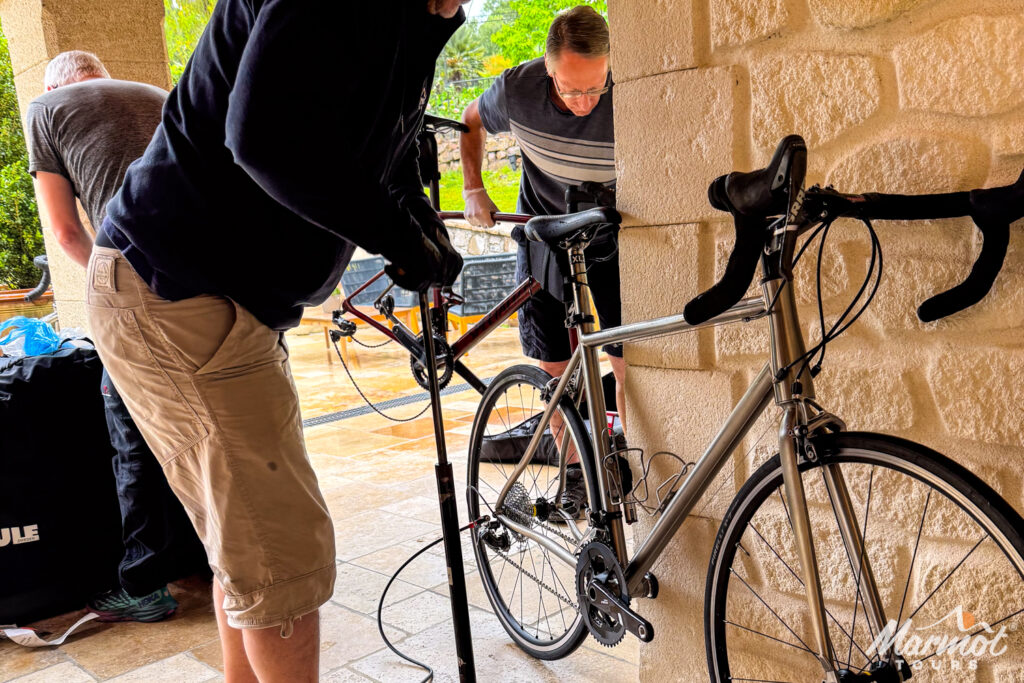
You might be anxious about your bike making it safely to your destination. Unfortunately, airlines do occasionally misplace bike boxes, or they become delayed, meaning you could face starting your cycling holiday without your bike – not ideal! We usually carry a spare bike in our vans (although we can’t guarantee it will be in your size), so we should be able to get you on the road while you wait for your own bike to arrive. There’s a higher chance of bike boxes being misplaced when you need to catch interconnecting flights to get to your final destination. The top tip here is to put an Airtag or similar device in your bike box so you can track it! Our guides always do their best to support you with logistics if your bike has gone astray (subject to them also supporting the rest of the group), but it’s usually a case of claiming on your travel insurance, for any additional costs you might incur as a result of a lost or delayed bike box.
Hiring a bike from us
The main benefit of hiring one of our bikes links back to the last point: you can avoid the risk of your bike going missing or being delayed by hiring one of our fleet instead. Also, you’ll have no unpacking and rebuilding to do on the first day of your holiday, leaving you more time to mingle with your fellow riders, and get prepared for the first day of cycling. Our support vehicles carry spare parts for our hire bikes, so if anything needs replacing while you’re on the road, we’ll have you covered – from brake pads and tyres, all the way to bar tape and bottom brackets! At the end of each day, our guides safety check your hire bike, meaning you can be confident that it’s ship-shape for the following day’s ride. Finally, at the end of the tour, you simply hand your hire bike back to our guides, who take care of washing and preparing it for the next cyclist.
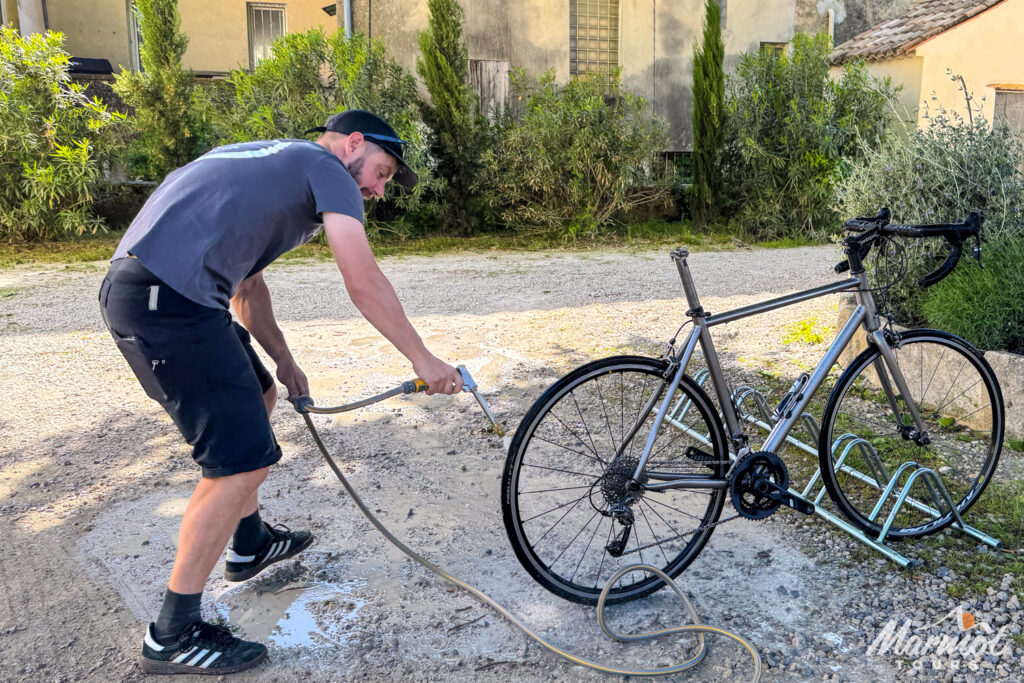
Hiring a bike from us also gives you the opportunity to try out a titanium frame and possibly a different set up to what you’re used to with your own bike, which might be useful if you’re looking to change some of your components and want a test drive first.
The Marmot Tours hire bike fleet
Our fleet comprises custom-built, titanium framed bikes, with a geometry designed especially for riding in the mountains. They are also geared with climbing in mind. This design ensures riders will be comfortable cycling in the mountainous terrain found on our itineraries and for multiple long days in the saddle.
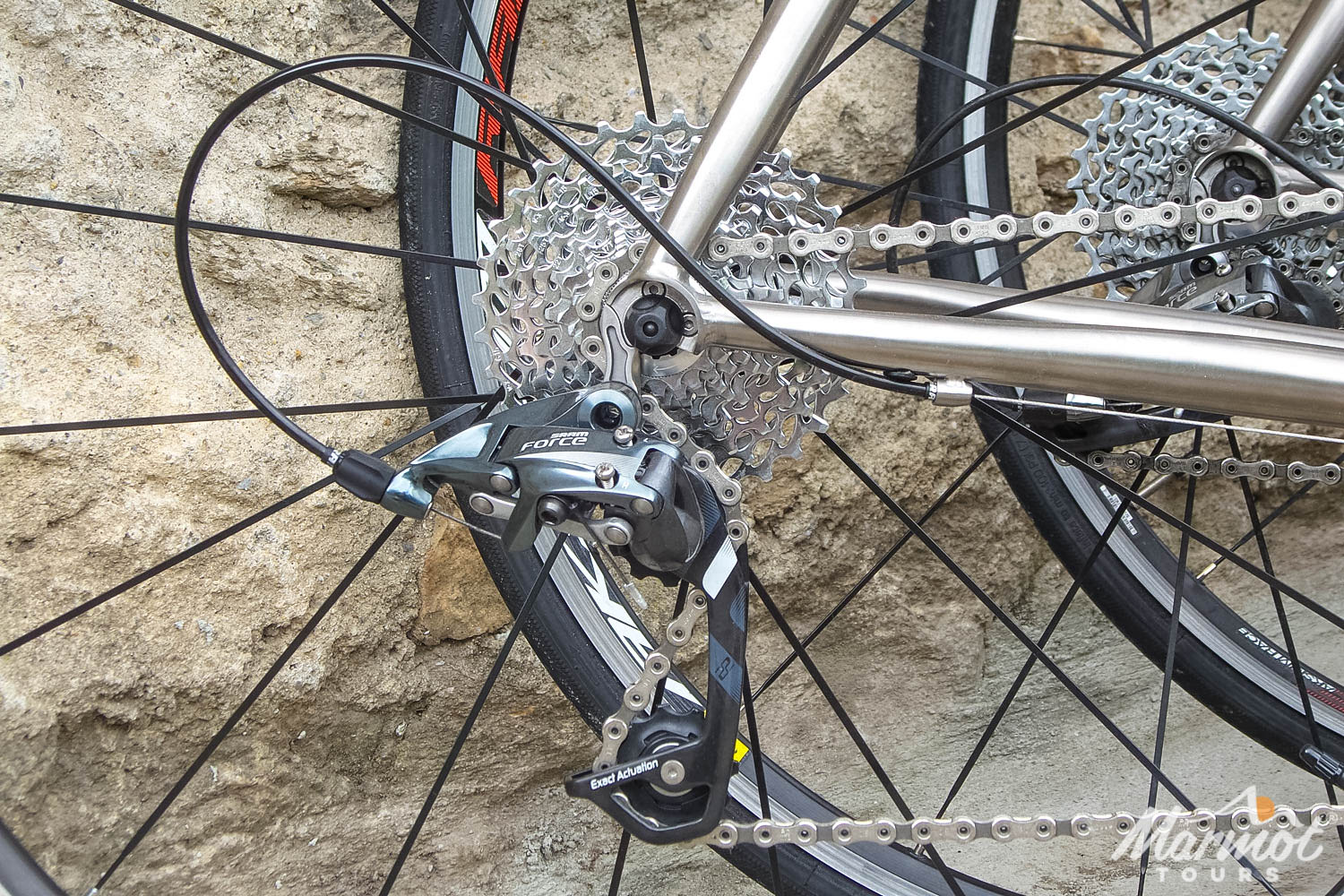
The full spec is as follows:
- Custom titanium frame and fork with comfortable geometry to keep you feeling great on the bike all day and all week!
- 11 speed SRAM Force group set with a 11-36 cassette and a 50/34T chain set: the optimum granny gears to get you up even the steepest climbs!
- Mavic Aksium wheels wrapped in Pirelli P7 Sport 26mm tyres.
- 2 bottle cages for those long thirsty days in the saddle.
- Saddle bag with spare tube and tyre levers with a frame-mounted pump.
- SRAM Force rim brakes with Swiss Stop brake pads.
- Deda stem and bars with a generous steerer tube to accommodate spacers for a variety of heights at the front end.
- Gel inserts under our bar tape to ensure your hands, wrists, elbows, shoulders and neck are not taking too much vibration from the road.
You can read more details about the spec on the Hire Bikes page of our website.
“Will I be able to get the correct fit?” you ask
All bike geometries are slightly different, so it’s not always possible to get the exact same bike fit from one frame to the next. However, our vans contain our comprehensive ‘bike fit’ box with a variety of different length stems & spacers so we can get your bike fit tailored to you. We can move the saddle backwards, forwards, up, down, and tilt it, as well as moving the handlebars up and down, and changing the stem to adjust the reach to get the bike feeling as comfortable as possible.
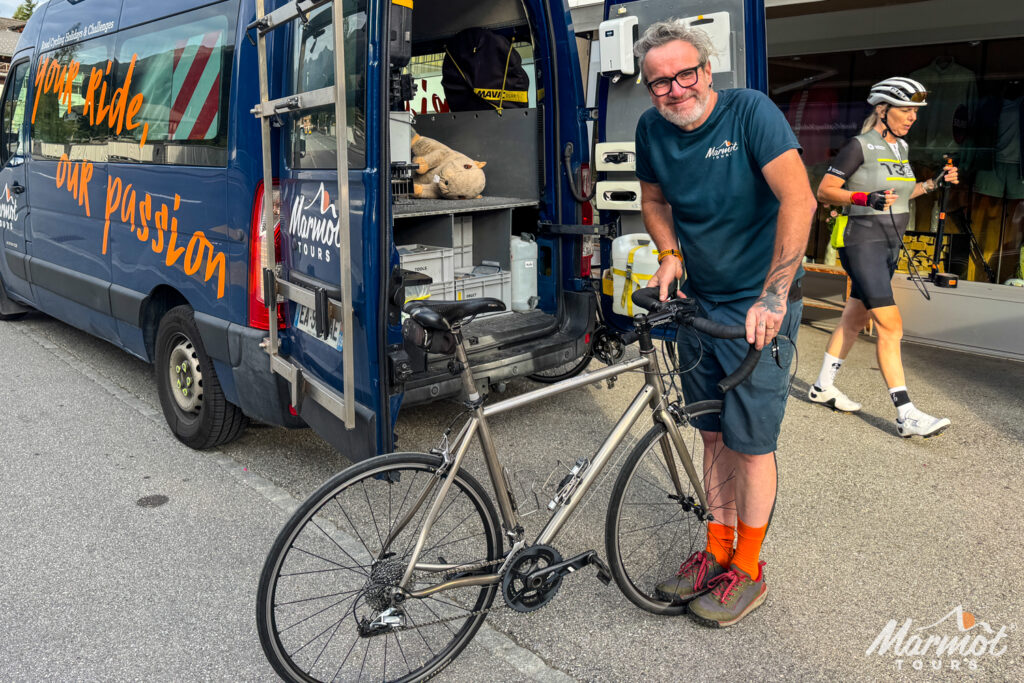
Our guides are well versed in what to look for to help you get the optimum set up and to ensure your comfort while riding. With torque wrenches and grease at the ready we’ll make sure you’re feeling at home on one of our hire bikes, leaving you to enjoy the ride, and to take in the beautiful scenery surrounding you!
We advise you to bring your own saddle to make you feel more at home on one of our bikes. You’re welcome to use ours but it won’t be familiar to you. As for pedals, please bring your own, so that they work most effectively with your cleats.
“How are the bikes set up? Will I be OK using the brakes and gears?”
The rim brakes on our hire bikes are set up with the levers ‘UK style’, meaning that the front brake lever is on the right and the rear brake lever is on the left. This may be different to the set up you’re used to, for example if you’re Europe or North America based. If this is the case, we recommend using both brakes evenly until you’re comfortable and confident knowing which is which.
SRAM is our brand of choice for our groupset. It uses the ‘double tap’ system: each gear lever sits behind the brake lever, and it requires two clicks or taps to change the gears. In your right hand you’ll change your rear mech, with the first click changing down the cassette into a harder gear. Pushing past this first click to the second click will change your rear mech up the cassette to an easier gear. In your left hand you’ll change your front mech. The first click will change you from the big (outer) ring to the small (inner) ring. Pushing and holding the lever to the second click will move the change from the small (inner) ring to the big (outer) ring.
NOTE: This may sound complicated – it is indeed much harder to explain in writing than it is to put into practice! We assure you that a quick spin around the car park to try it out will soon leave you feeling very confident with how the groupset works!

“How do I hire a bike from you?”
Our bikes are in high demand, and we have a limited number of sizes available so we rent them on a first-come-first-served basis. As such, if you’d like to hire, please make us aware of this at the time you make your holiday enquiry, so we can discuss your size requirements and see if there is availability. We suggest you bring your own bike as a first option, and consider hiring from us as a back up plan if this is less feasible, i.e. if you are travelling long haul.
“Can I hire a bike on any Marmot Tours road cycling holiday?”
Unfortunately not. Due to local regulations, we’re unable to take our hire bike fleet to Tenerife or Gran Canaria, so we arrange bike hire from a local operator on both Canary Islands.
However, subject to availability, our hire bikes are available on all our other road cycling holidays in France, Spain, Italy, Switzerland and Slovenia.

Credit: John O’Sullivan.

